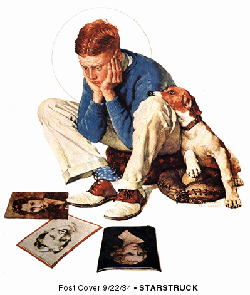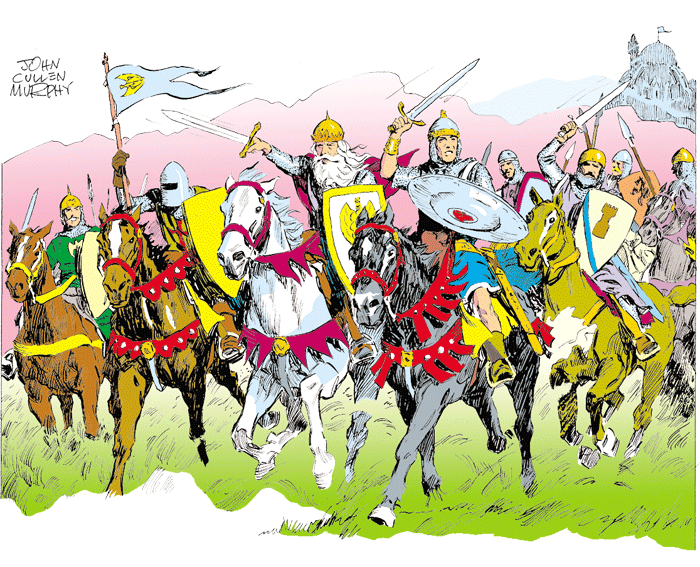|
JK: It was a good working relationship then?
John Cullen Murphy: Oh yeah. He was like another Father
to me. Great guy. A lovely wife too. But they're both gone.
JK: He passed away in '82?
John Cullen Murphy: Yeah. He would have been ninety
in another week or two.
JK: Then he passed away just a couple years after he
stopped scripting it.
John Cullen Murphy: Yeah, that's right. I kept in touch
with him all the time, but he wasn't well. I think he had an
artificial hip put in.
JK: You mentioned he sold the ownership. Was it hard
for him to give up the strip?
John Cullen Murphy: Sure,because it was his baby, his
creation.
JK: I understand he initially had it plotted out until
Prince Valiant's death.
John Cullen Murphy: He wasn't sure if he wanted it
to continue on after he died or retired, and he was going to
have one big Armageddon where everyone would come in and get
killed, but then he took pity on me and kept it going for my
sake.
JK: Very nice of him.
John Cullen Murphy: Well, I'm a nice guy.
JK: (laughs) When I saw you up at the tribute
they had for you at the NCS function in Connecticut last November,
you had your son there who writes the strip and your daughter
who letters and colors it. You mentioned your son took over the
writing after Foster. Has your daughter Meg been lettering and
coloring since then also?
John Cullen Murphy: No, in fact for a while I did the
lettering myself. Ben Oda did the lettering at first and then
he died. Remember him from King Features? He was very well known
down at the syndicate, if there's anybody left there.
JK: I started at King Features in '89 and I don't remember...
John Cullen Murphy: No, he was gone by then, long gone.
JK: One of the nice things about when I worked on staff
was seeing full size artwork when it came in. I especially remember
those big panels you'd occasionally do.
John Cullen Murphy: Y'know, years ago, people use to
go into that storeroom there and walk out with the stuff. I was
never in that place in my life to tell you the truth.
JK: Well, they're much better about storing things
now. The only reason they have all the old Flash Gordon proofs
from the thirties is because they bought them from the Raymond
estate.
John Cullen Murphy: To me that was his peak period,
those earlier things. Marvelous.
JK: To segue into another question, on Flash Gordon
there's been Austin Briggs, there's been Dan Barry...there's
been a lot of artists since Raymond, and on Prince Valiant it
went from Hal Foster to you...
John Cullen Murphy: Well, he had a couple guys for
a few weeks I guess, and then I took over the whole thing.
JK: It's been thirty years now, right?
John Cullen Murphy: In August.
JK: Was there any initial pressure when you first started?
John Cullen Murphy: Nah, I was very confident. I was
almost fifty years old at the time. I had been in this business
ever since I can remember and I knew Hal personally for years
before.
JK: It seems like the comic strip illustrators of your
generation tended to come from magazine illustration and formal
training, where they don't as much today.
John Cullen Murphy: Yeah, like Briggs and all that.
Alex Raymond's younger brother was my assistant for fifteen years.
So I knew all the Raymonds very well.
JK: Which brother was that?
John Cullen Murphy: George.
JK: And then Jim Raymond did Blondie, right? So the
whole family did comic strips or..?
John Cullen Murphy: No, they were the only other two.
George began as my assistant after I started Ben Bolt. He did
all the lettering, laid things out for me and did research.
JK: On a strip like Prince Valiant where you have all
the historical aspects and settings, how much time goes into
research and reference?
John Cullen Murphy: I couldn't tell you. I have lots
of stuff right here, books and things, Hal gave me a pile of
books. But there's not much research on that, nobody knows anything
about that period. It's just a bunch of barbarians, unless they
were kings or something, they pretty much dressed the same. We
take a lot of liberties with it. We have elaborate palaces and
castles. This was the time of the barbarians, right after the
fall of the Roman Empire. Instead of being enormous marble castles
what they really had was probably wooden stockades and that sort
of thing. But you want to make it pictorial and interesting looking.
JK: You mentioned having an assistant on Ben Bolt,
do you have assistants now?
John Cullen Murphy: No. The last year or two Frank
Bolle had been helping me with lay outs and that sort of thing,
but the pen work was all mine. I went over all the drawings.
JK: In one of Foster's last interviews he wrote that
you're a very good illustrator in that you can make the hands
talk, that they confirm the expression on the face. What do you
see as the points that make up a strong illustration?
John Cullen Murphy: Light is very important. You're
like a stage designer and you want to have it as powerful as
you can, so you have big strong blacks and such. But it's a combination
of drawing and composition and lighting.
JK: Do you do much painting these days?
John Cullen Murphy: I painted today. I do oil paintings,
portraits and things.
JK: Do you still do freelance in addition to Prince
Valiant?
John Cullen Murphy: No. What I do is for myself or
for my 8 kids or their children, my 16 grandchildren. I use to
do these big oil paintings, these big chairman of the board things
and all that.
JK: I'm going over my notes and there's Norman Rockwell,
Booth, Foster. You just run the gamut here.
John Cullen Murphy: I use to go to the Art Student's
League one night a week and I'd paint portraits under a great
portrait painter named Sidney Dickinson. I don't know if you'd
remember the name.
I was very fortunate in my mentors.
|




